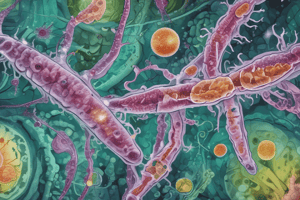Podcast
Questions and Answers
What is a critical nursing intervention for a patient receiving cephalosporins?
What is a critical nursing intervention for a patient receiving cephalosporins?
- Monitor cardiac function
- Monitor for signs of hypertension
- Monitor respiratory rate
- Monitor urinary function (correct)
Which of the following antibiotics is effective against MRSA?
Which of the following antibiotics is effective against MRSA?
- Amoxicillin
- Vancomycin (correct)
- Ceftriaxone
- Cefazolin
What should be avoided when administering cephalosporins?
What should be avoided when administering cephalosporins?
- Alcohol consumption
- Calcium-rich products (correct)
- Food intake
- Non-steroidal anti-inflammatory drugs (NSAIDs)
In what way do cephalosporins primarily act against bacteria?
In what way do cephalosporins primarily act against bacteria?
Which of the following is an example of a first-generation cephalosporin?
Which of the following is an example of a first-generation cephalosporin?
What type of infections can cephalosporins effectively treat?
What type of infections can cephalosporins effectively treat?
Which of the following adverse effects is associated with cephalosporins?
Which of the following adverse effects is associated with cephalosporins?
What is a recommended client teaching regarding the use of antibiotics?
What is a recommended client teaching regarding the use of antibiotics?
What is the primary purpose of penicillins in antimicrobial therapy?
What is the primary purpose of penicillins in antimicrobial therapy?
Which method is preferred for identifying microorganisms when gram stain does not yield a positive identification?
Which method is preferred for identifying microorganisms when gram stain does not yield a positive identification?
Which of the following is a potential adverse effect of penicillins?
Which of the following is a potential adverse effect of penicillins?
Before administering antibiotics, what should be collected to ensure appropriate treatment?
Before administering antibiotics, what should be collected to ensure appropriate treatment?
Which of the following is NOT an example of a narrow spectrum penicillin?
Which of the following is NOT an example of a narrow spectrum penicillin?
Which nursing intervention is important when administering penicillins via intramuscular injection?
Which nursing intervention is important when administering penicillins via intramuscular injection?
What is a common teaching point for clients prescribed penicillins?
What is a common teaching point for clients prescribed penicillins?
Which function is primarily inhibited by the method of action of certain antimicrobials?
Which function is primarily inhibited by the method of action of certain antimicrobials?
Flashcards are hidden until you start studying
Study Notes
Principles of Antimicrobial Therapy
- Antimicrobials are used to treat infections caused by bacteria, viruses, fungi, and parasites.
- Mechanisms of action include:
- Destroying bacterial cell walls.
- Inhibiting unique bacterial enzymes essential for survival.
- Impairing protein synthesis in ribosomes.
- Disrupting RNA and DNA synthesis/functions.
- Inhibiting viral replication.
- Classified into narrow-spectrum (target specific bacteria) and broad-spectrum (target a wide range of bacteria).
Selection of Antimicrobials
- Accurate identification of pathogens is essential for effective treatment.
- Lab tests (blood, urine, sputum, wound drainage) used to identify microorganisms.
- Gram stain allows direct identification of organisms under a microscope.
- Cultures grow colonies over time and are preferred if gram stains yield inconclusive results.
- Culture specimens must be collected before starting medication to avoid contamination.
Penicillins
- Serve to destroy bacteria by weakening their cell walls.
- Common uses include treating pneumonia, meningitis, endocarditis (prophylaxis), UTIs, and syphilis.
- Adverse effects involve anaphylaxis, nausea/vomiting/diarrhea (N/V/D), nephrotoxicity, thrombocytopenia, Steven-Johnson syndrome, and Clostridium difficile (C. diff).
- Prefix: -CILLIN, with examples including:
- Natural penicillins: Bicillin CR (narrow spectrum).
- Aminopenicillins: Amoxil (amoxicillin), Principin (ampicillin) (broad spectrum).
- Combination therapies: Augmentin, Zosyn, Unasyn.
- Extended spectrum: Geocillin, Ticar.
- Nursing interventions include administering via deep IM injection in large muscle, rotating sites, and ensuring medications are taken on an empty stomach.
- Client education emphasizes adherence to the full course and proper suspension storage.
Penicillins and Antibiotic Resistance
- Methicillin-resistant Staphylococcus aureus (MRSA) does not respond to standard penicillin therapies; requires higher potency antibiotics like Vancomycin.
- Vancomycin-resistant enterococci (VRE) represent a newer antibiotic resistance challenge.
Cephalosporins
- Prefix: CEF- and CEPH-, with examples:
- First Generation: Duricef (cefadroxil), Ancef (cefazolin), Keflex (cephalexin).
- Second Generation: Mefoxin (cefoxitin), Cefzil (cefprozil).
- Third Generation: Omnicef (cefdinir), Cefobid (cefoperazone), Claforan (cefotaxime), Rocephin (ceftriaxone).
- Function similarly to penicillins by destroying bacterial cell walls.
- Most drugs administered IM or IV due to poor GI absorption.
- Uses include respiratory infections, otitis media, bone/joint infections, UTIs, and surgical site infections.
- Adverse effects are similar to penicillins, including cross-sensitivity with PCN.
Inhibitors of Cell Wall Synthesis
- Key examples include Azactam (aztreonam), Primaxin (imipenem/cilastatin), and Vancomycin.
- Purpose is to disrupt bacterial cell walls leading to microorganism death.
- Primarily used against MRSA and C. diff infections.
Studying That Suits You
Use AI to generate personalized quizzes and flashcards to suit your learning preferences.





